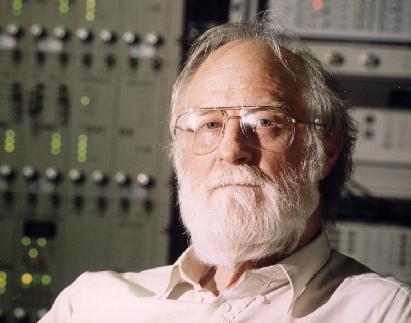Ron Ekers elected to Royal Society
 Professor Ron Ekers. Photo: Brad Collis
Professor Ron Ekers. Photo: Brad Collis
Professor R D (Ron) Ekers, the ATNF's Foundation Director and an ARC Federation Fellow, has been elected a Fellow of the Royal Society in the UK for his contributions to radio astronomy and the development of techniques for the field.
Ron's research interests include extragalactic astronomy, galactic nuclei and the techniques of radio astronomy. A hallmark of his career has been wide-ranging, innovative experiments. Former colleague Seth Shostak of the SETI Institute once described Ron as having "more ideas per unit time than anybody [else] I have encountered".
Ron, however, considers that at least part of his success was due to the good fortune of being in the right place at the right time. "All I did was to exploit the great telescopes and take advantage of research opportunities built up by the scientists and engineers who developed radio astronomy in Australia," he says.
After gaining his PhD from the Australian National University in 1967, Ron worked at the California Institute of Technology; the Institute of Theoretical Astronomy in Cambridge, UK; and at the Kapteyn Laboratory in Groningen, The Netherlands. Then, at the age of 39, he was recruited to become the first director of the VLA.
In 1987 Ron returned to Australia, headhunted again, to become the first director of the Australia Telescope National Facility; a role he continued in until he received a Federation Fellowship in 2003.
Ron has been Chairman of a number of international bodies: the International Union of Radio Science Commission J, which deals with radio astronomy; the International Steering Committee of the Square Kilometre Array radio telescope, the world's largest radio telescope now being planned by 17 countries; and the Anglo-Australian Telescope Board, which is responsible for the largest optical telescope in Australia. He is currently president of the International Astronomical Union.
In 1993 Ron was elected a Fellow of the Australian Academy of Science and a Foreign Member of the Royal Dutch Academy of Science; in 2003 he became a Member of the American Philosophical Society. In 2005 he was awarded the Australian Academy of Science's Flinders Medal for research in the physical sciences.
Ron joins a small, select group of Royal Society Fellows associated with Australian radio astronomy. Edward "Taffy" Bowen, long-term Chief of the Division of Radiophysics (the ATNF's predecessor) became an FRS; so too did David Martyn, who was RP Chief during 1940 – 1941; Joseph Pawsey, the first head of the radio astronomy group in Radiophysics; and John Bolton, first director of the Parkes Observatory.
Founded in 1660, the Royal Society is the oldest scientific academy in continuous existence. Fellows are elected by peer review, for life, and do not have to be British nationals. The Society has about 1300 Fellows and Foreign Members.
Helen Sim
(Helen.Sim@csiro.au)
